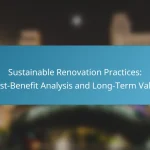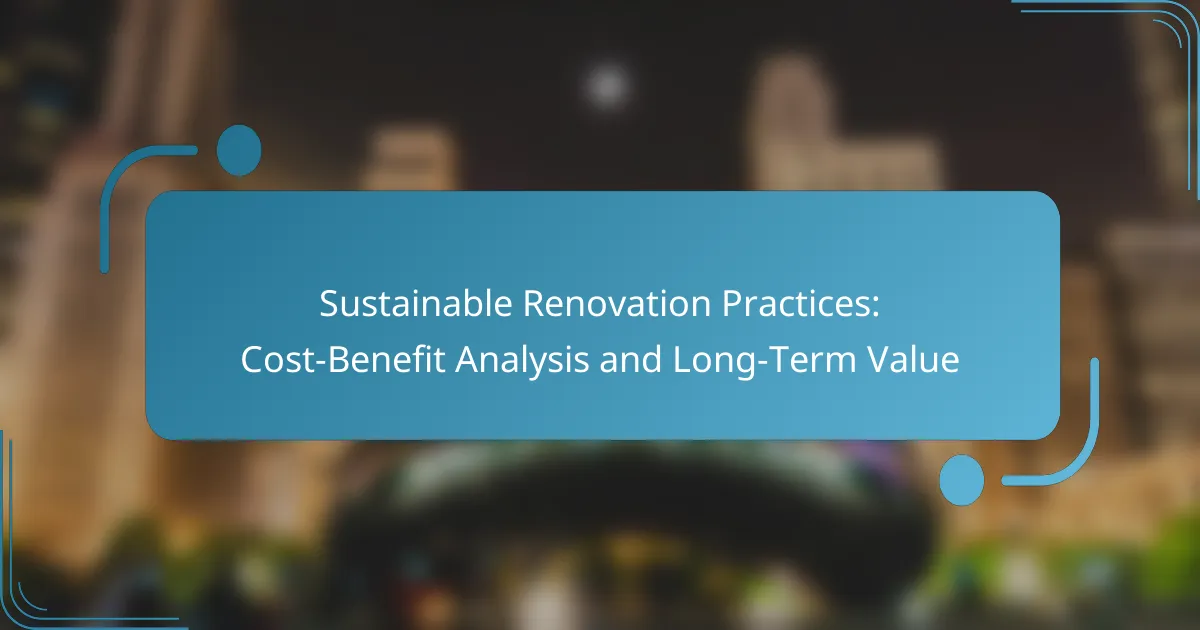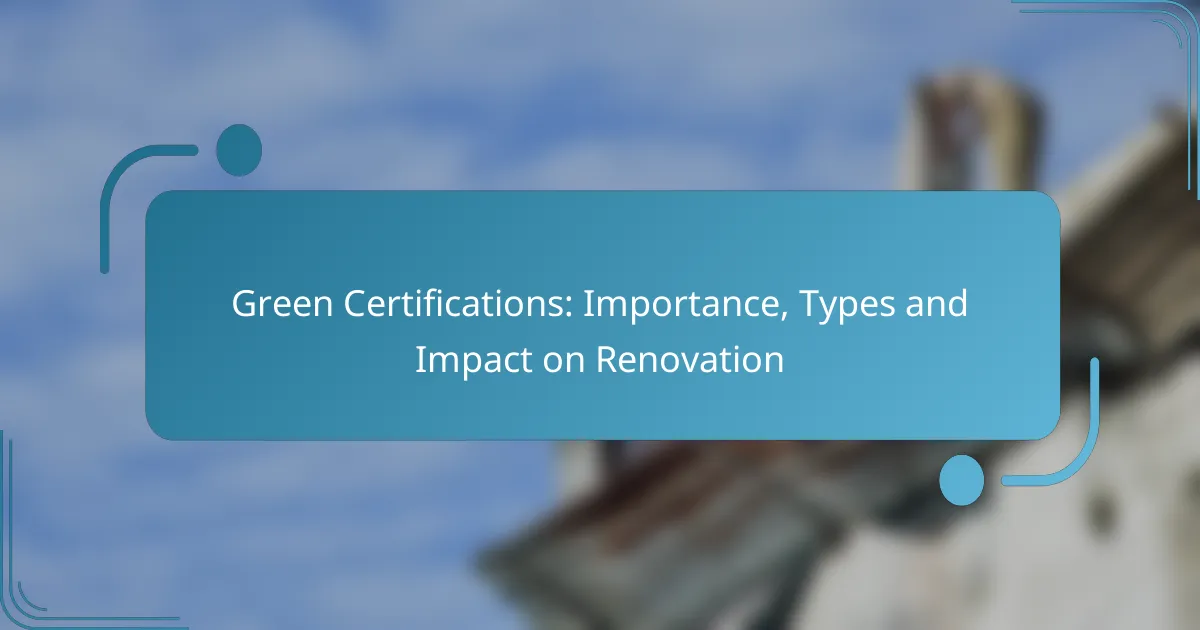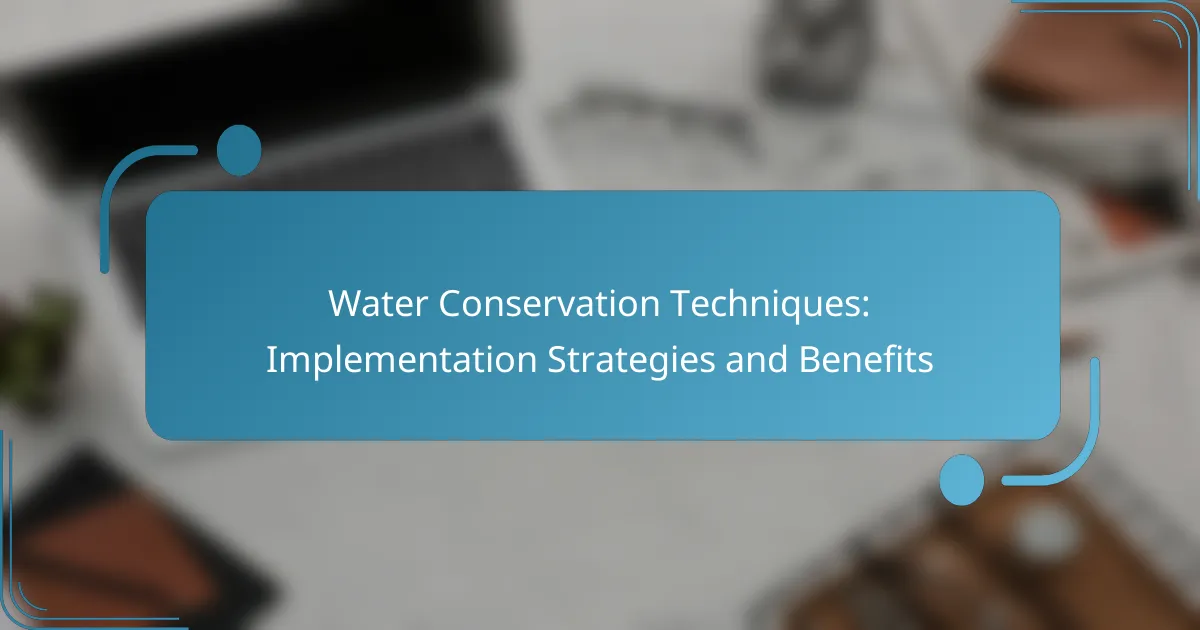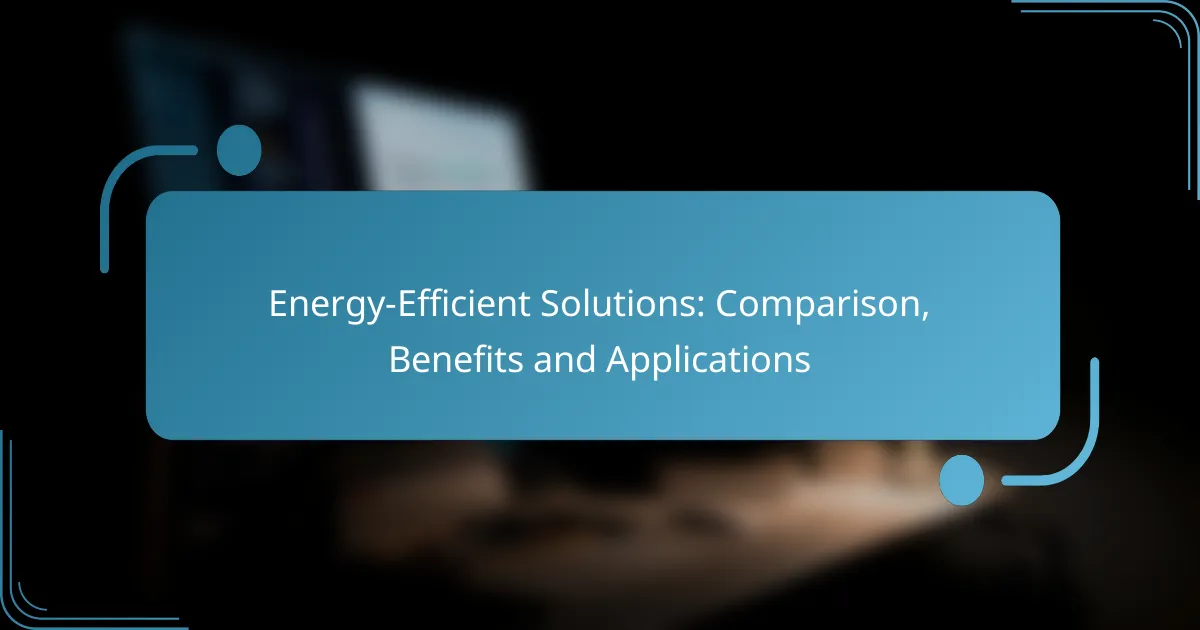Sustainable renovation practices are essential for urban areas, emphasizing energy efficiency, water conservation, and the use of eco-friendly materials. By implementing these strategies, homeowners can not only minimize their environmental footprint but also enjoy long-term cost savings and increased property value. A thorough cost-benefit analysis reveals that while initial investments may be significant, the potential for enhanced resale values and reduced operating costs makes sustainable renovations a wise financial decision.

What are the best sustainable renovation practices in urban areas?
The best sustainable renovation practices in urban areas focus on enhancing energy efficiency, conserving water, and utilizing eco-friendly materials. These methods not only reduce environmental impact but also offer long-term cost savings and improved property value.
Energy-efficient insulation
Energy-efficient insulation is crucial for maintaining comfortable indoor temperatures while minimizing energy consumption. Upgrading to high-performance insulation materials, such as spray foam or cellulose, can significantly reduce heating and cooling costs.
Consider the R-value, which measures insulation effectiveness; higher R-values indicate better thermal resistance. In urban settings, retrofitting existing structures with improved insulation can lead to energy savings of 20-30% annually.
Solar panel installation
Installing solar panels is a highly effective way to harness renewable energy and lower electricity bills. Urban homeowners can benefit from various incentives, such as tax credits and rebates, which can offset initial installation costs.
Typically, solar panel systems can reduce energy costs by 50-70%, depending on local sunlight availability and energy consumption patterns. It’s essential to assess roof orientation and shading to maximize efficiency.
Water-saving fixtures
Water-saving fixtures, such as low-flow faucets, showerheads, and dual-flush toilets, help reduce water usage without sacrificing performance. These fixtures can lower water bills and contribute to sustainability goals in urban areas facing water scarcity.
Upgrading to water-efficient products can lead to savings of 20-50% on water usage. Look for fixtures with the WaterSense label, which indicates they meet EPA standards for efficiency.
Recycled materials usage
Utilizing recycled materials in renovations minimizes waste and reduces the demand for new resources. Common options include reclaimed wood, recycled metal, and repurposed bricks, which can add character and sustainability to urban projects.
When selecting materials, consider their environmental impact and sourcing. Using recycled materials can lower costs and contribute to LEED certification, enhancing property value.
Green roofing systems
Green roofing systems involve planting vegetation on rooftops, providing insulation, reducing stormwater runoff, and improving air quality. These systems are particularly beneficial in urban areas, where green space is limited.
Installing a green roof can lower energy costs by providing natural insulation and can last longer than traditional roofing materials. Consider local climate and plant selection to ensure successful growth and maintenance.
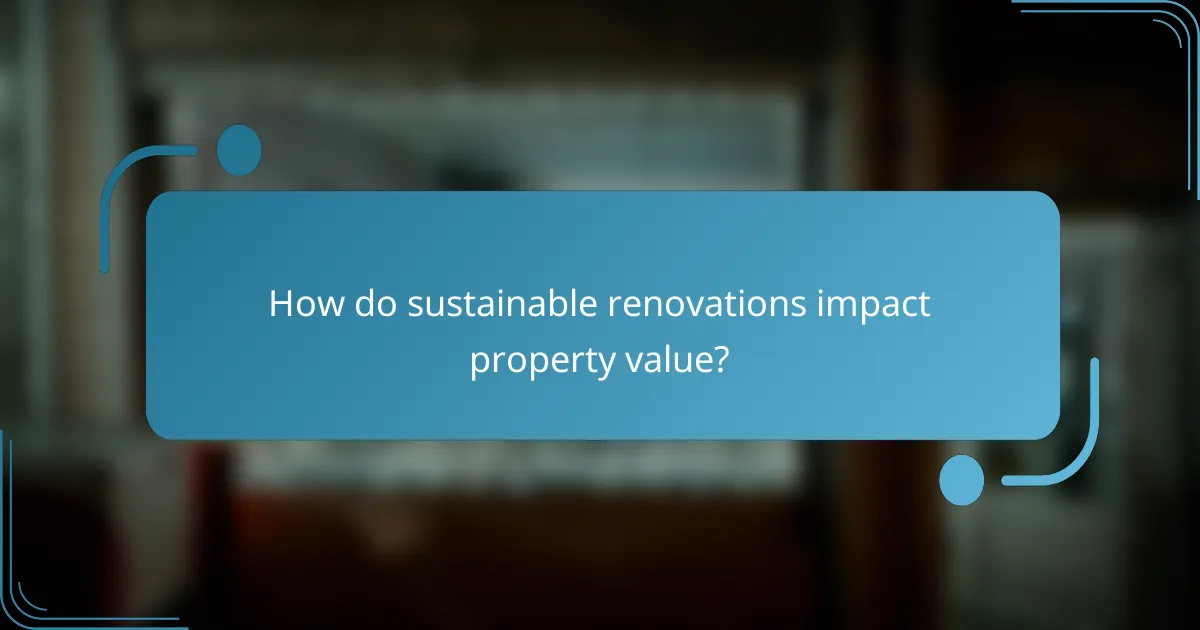
How do sustainable renovations impact property value?
Sustainable renovations can significantly enhance property value by improving energy efficiency and reducing environmental impact. Homeowners often see a return on investment through increased resale values and lower operating costs.
Increased resale value
Sustainable renovations typically lead to higher resale values, as buyers are increasingly willing to pay a premium for energy-efficient homes. Studies suggest that properties with green certifications can sell for 5-15% more than comparable homes without such features.
Investing in high-quality insulation, energy-efficient windows, and solar panels can contribute to this increased value. These upgrades not only make the home more attractive but also demonstrate a commitment to sustainability, appealing to a growing market segment.
Attractiveness to eco-conscious buyers
Eco-conscious buyers actively seek homes that reflect their values, making sustainable renovations a strong selling point. Features such as rainwater harvesting systems, native landscaping, and energy-efficient appliances can draw interest from this demographic.
Marketing your home’s sustainable features can enhance its appeal. Highlighting certifications like LEED or Energy Star can attract buyers who prioritize environmental responsibility, potentially leading to quicker sales.
Long-term savings on utilities
Sustainable renovations often result in significant long-term savings on utility bills. Energy-efficient upgrades can reduce heating and cooling costs by 20-50%, depending on the improvements made.
Homeowners should consider the payback period for these renovations. While initial costs may be higher, the cumulative savings over time can offset these expenses, making sustainable renovations a financially sound choice.
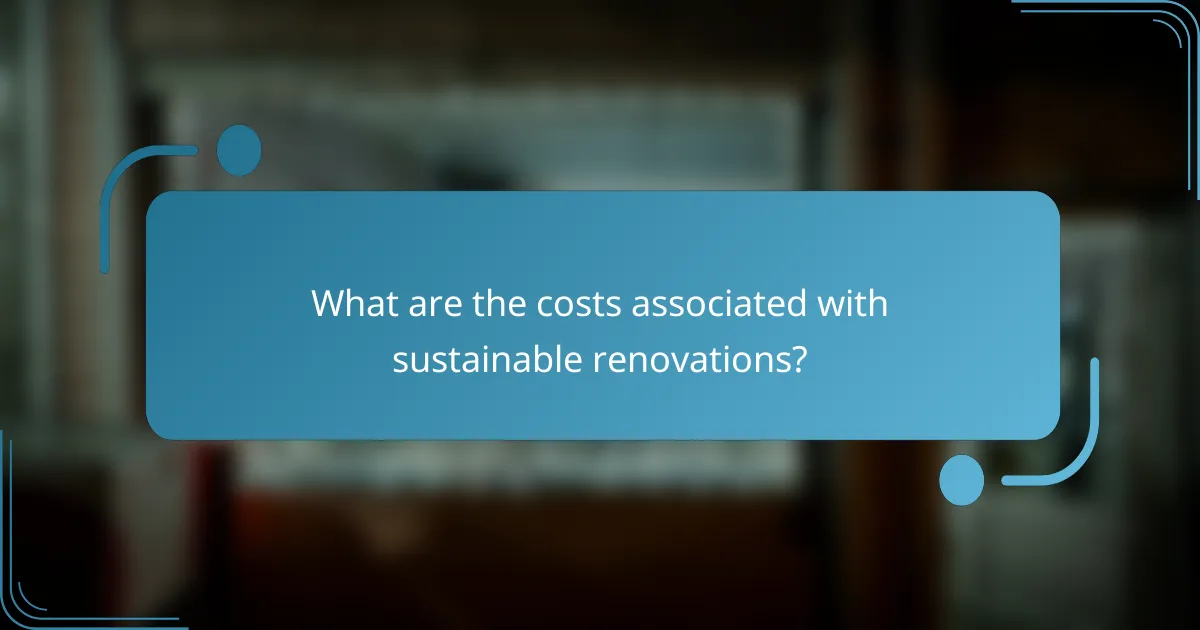
What are the costs associated with sustainable renovations?
Sustainable renovations often involve various costs that can impact the overall budget. These costs include initial investments, potential tax incentives, and financing options that can alleviate financial burdens.
Initial investment costs
The initial investment costs for sustainable renovations can vary significantly based on the scope of the project. Homeowners might expect to spend anywhere from a few thousand to tens of thousands of dollars, depending on the materials and technologies chosen, such as energy-efficient windows or solar panels.
It’s essential to consider the long-term savings on energy bills when evaluating these upfront costs. For instance, while high-efficiency appliances may cost more initially, they can lead to substantial savings over time.
Potential tax incentives
Many governments offer tax incentives for sustainable renovations, which can help offset initial costs. Homeowners in the United States, for example, may qualify for federal tax credits for installing solar energy systems or energy-efficient heating and cooling systems.
It’s advisable to research local and state-level incentives as well, as these can vary widely. Keeping track of available programs can significantly reduce the financial burden of sustainable renovations.
Financing options for green renovations
Financing options for green renovations include specialized loans and grants designed to support energy-efficient upgrades. Programs like Energy Efficient Mortgages (EEMs) allow homeowners to finance the cost of energy improvements as part of their mortgage.
Additionally, some financial institutions offer green loans with lower interest rates for projects that meet specific sustainability criteria. Homeowners should compare these options to find the most favorable terms and conditions for their renovations.
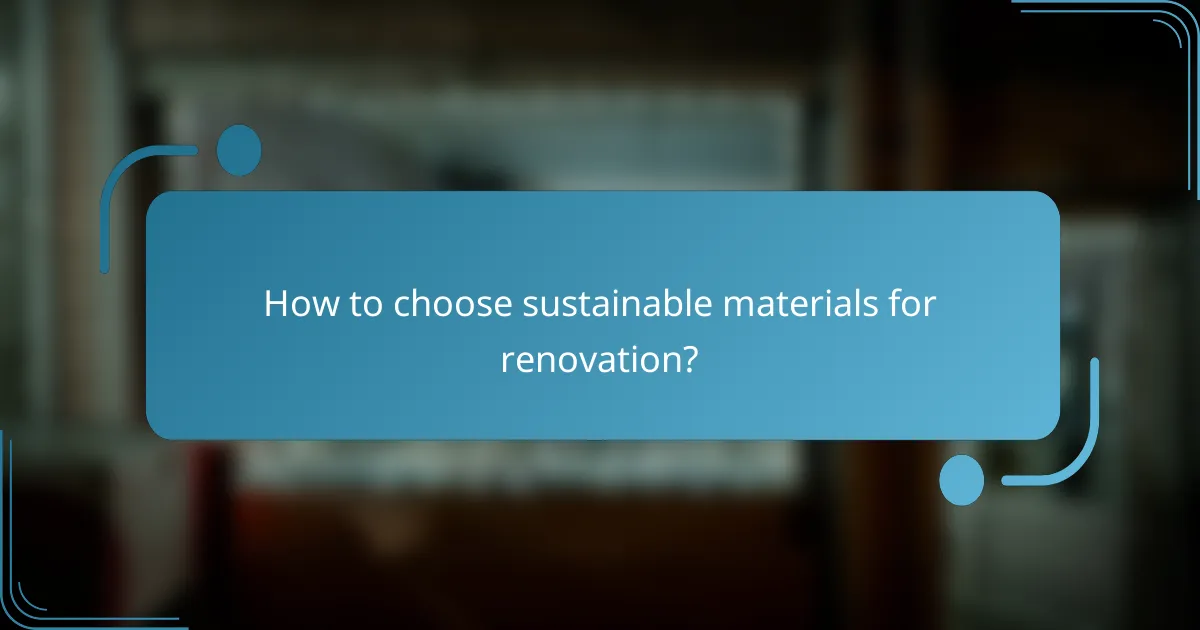
How to choose sustainable materials for renovation?
Choosing sustainable materials for renovation involves selecting options that minimize environmental impact while maximizing efficiency and durability. Focus on materials that are renewable, recycled, or locally sourced to ensure a lower carbon footprint and better long-term value.
Certifications to look for
When selecting sustainable materials, look for certifications that indicate environmental responsibility. Common certifications include LEED (Leadership in Energy and Environmental Design), FSC (Forest Stewardship Council), and Energy Star. These labels help ensure that materials meet specific sustainability criteria.
Additionally, consider products with low VOC (volatile organic compounds) emissions, which contribute to better indoor air quality. Checking for these certifications can guide you toward healthier and more sustainable choices.
Local sourcing benefits
Local sourcing of materials can significantly reduce transportation emissions and support the local economy. By purchasing from nearby suppliers, you not only decrease the carbon footprint associated with shipping but also often gain access to unique materials that reflect regional characteristics.
Moreover, local materials may require less processing and packaging, further enhancing their sustainability. Engaging with local artisans can also foster community relationships and promote craftsmanship.
Durability and maintenance considerations
Durability is a key factor in sustainable renovation, as longer-lasting materials reduce the need for frequent replacements. Opt for materials known for their longevity, such as stone, metal, or high-quality wood, which can withstand wear and tear over time.
Maintenance requirements also play a crucial role; materials that are easy to maintain and repair contribute to sustainability by extending their lifespan. For instance, choosing finishes that require less frequent repainting or sealing can save resources and time in the long run.
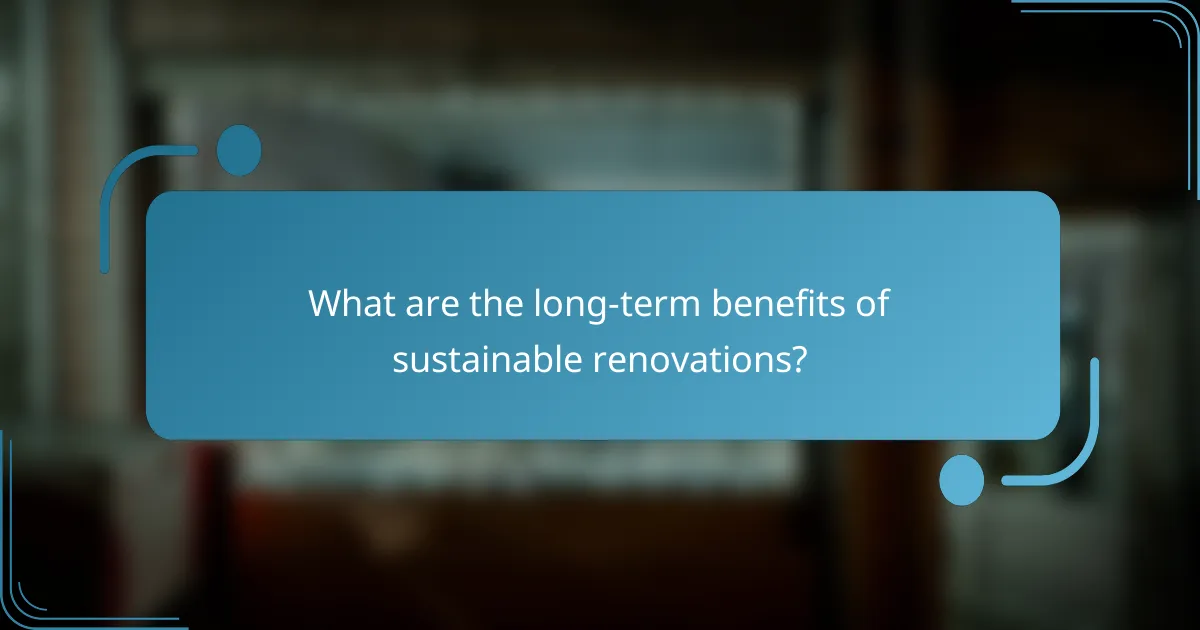
What are the long-term benefits of sustainable renovations?
Sustainable renovations offer numerous long-term benefits, including increased property value, reduced operational costs, and enhanced environmental impact. By integrating eco-friendly materials and energy-efficient systems, homeowners can enjoy both immediate savings and lasting advantages.
Reduced carbon footprint
Implementing sustainable renovation practices significantly lowers a building’s carbon footprint. This is achieved through energy-efficient appliances, renewable energy sources, and sustainable materials that minimize environmental impact. For instance, using solar panels can reduce reliance on fossil fuels, leading to a decrease in greenhouse gas emissions.
Homeowners should consider energy-efficient windows, proper insulation, and sustainable landscaping as effective strategies to further reduce their carbon footprint. These improvements not only contribute to environmental sustainability but can also lead to lower energy bills over time.
Improved indoor air quality
Sustainable renovations enhance indoor air quality by using non-toxic materials and improving ventilation systems. This is crucial for maintaining a healthy living environment, as poor air quality can lead to respiratory issues and other health problems. For example, opting for low-VOC paints and finishes can significantly reduce harmful emissions indoors.
Incorporating natural ventilation and air purification systems can further improve air quality. Homeowners should regularly maintain these systems to ensure they function effectively, thus promoting a healthier home environment for all occupants.



